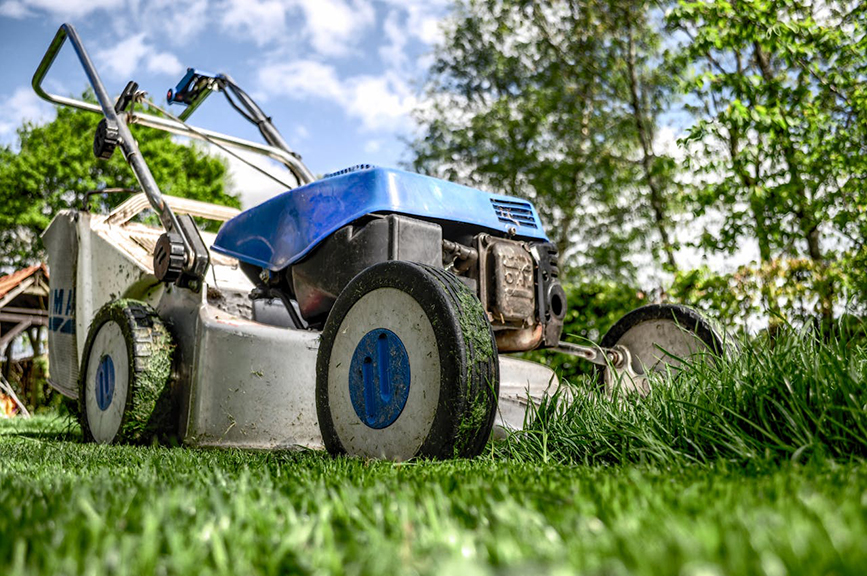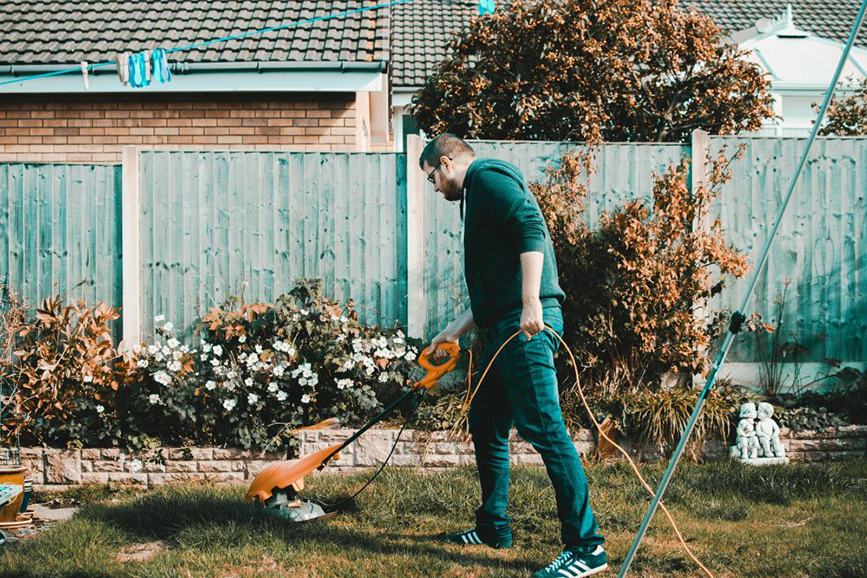 |
| A good-looking lawn starts with the right tools. You can put in all the effort, but if your gear is old or underperforming, the results will suffer. Many people hang onto their lawn equipment far too long, thinking it still “works fine.” But that can cost you more in the long run. Knowing when to upgrade your lawn care equipment is key to getting better results with less effort. Let’s break down the real signs that your tools are holding you back. |
| Your Lawn Looks Bad, and It’s Not the Grass’s Fault |
If your lawn looks uneven or scalped even after mowing, don’t blame the grass. That’s a red flag that your mower isn't doing its job right. Blades might be dull or damaged, and even if you sharpen them, an old mower deck might not cut evenly anymore. As a matter of fact, uneven wheels or a bent frame can cause your mower to scalp high spots and miss others completely.
On top of that, dull blades don’t slice—they tear. Torn grass blades turn brown and make your lawn look stressed. Besides, ragged cutting makes your lawn more likely to suffer from pests or diseases. If you see thin patches or browning even after mowing carefully, check your equipment. A new, sharper mower could solve those issues fast.
Another key point is that this goes beyond looks. Damaged grass grows more slowly and needs more recovery time. That means more work for you just to keep it alive. Upgrading to a newer mower with a better blade system can give you cleaner cuts, better health, and a faster mowing time. |
 |
| Uneven or browning grass after mowing often means your mower—not your lawn—is the real problem |
| Too Much Time and Money Going Into Repairs |
You might think it's smart to fix an old mower instead of buying a new one. And once or twice, maybe it is. But if you're constantly heading to the shop or replacing parts, you’re throwing money at a sinking ship. Most people don’t realize how much they’re spending each season. Add it up—belts, spark plugs, wheels, blades, filters—it adds up quickly.
In contrast, newer tools break down far less and often come with multi-year warranties. Plus, modern parts are easier to find. With this in mind, remember your time matters too. Waiting on parts or borrowing equipment while yours is in the shop delays your whole lawn schedule. You’re losing hours, and that’s before counting the cost of actual repairs.
Frequent breakdowns are more than just annoying—they’re a strong sign your gear is worn past its prime. Upgrade your lawn care equipment before you’ve spent more on repairs than a new model would cost.
|
 |
| Constant mower repairs, drain time, and money—upgrading often costs less than keeping old gear alive |
| Preparing Your Equipment for Seasonal Changes and Travel |
When seasons change or you’re getting ready to relocate, taking time to prepare your gear pays off. Moving often means packing your power tools for the trip, so you’ll want to handle them the right way. Begin by gathering sturdy boxes, protective padding, and any manuals you might need for reassembly. Detach all removable parts like blades or attachments to prevent damage in transit.
Next, clean every piece of equipment to remove dirt, grass, or moisture. Even a small amount of debris can lead to rust, clog moving parts, or create problems down the line. Check fuel levels—old gasoline sitting in tanks for months can harm your engine. It’s also smart to remove batteries, keep them partially charged, and store them in a cool, dry spot to protect them from humidity. By giving your tools this attention before the move, you’ll avoid costly repairs and be ready to get back to work when you arrive. |
 |
| To upgrade your lawn care equipment’s lifespan, clean and store it properly, especially in Tennessee’s shifting, humid climate |
| It’s Getting Harder to Start and Run Your Equipment |
There’s nothing more frustrating than pulling the starter cord 15 times with no results. If your equipment is hard to start or doesn’t stay running, something’s failing. Worn carburetors, clogged fuel lines, and bad ignition systems are common in older gas-powered tools. You could replace those, sure—but if you’re dealing with this every few weeks, that’s a red flag.
New gear often has a push-button start or modern electric ignition. You don’t need to pull cords or worry about gas issues. Electric options also mean no winter fuel storage problems. Many of today’s battery-powered tools start instantly and run quietly, making the whole job less of a hassle.
Besides, tools that don’t start on the first few tries waste more than time. They drain your patience and break your focus. If it’s a struggle to get through the job, your gear is probably the reason.
|
| Vibrations, Noise, and Discomfort Are Telling You Something |
Have you noticed your hands go numb after using your trimmer or mower? Does the engine seem louder than it used to be? These aren’t small annoyances—they’re warnings. Excess vibration means worn parts, loose bolts, or engine issues. Noise often signals something shaking or running hot.
Another key point is that tools with high vibration or sound levels are harder on your body. Over time, they cause fatigue, wrist pain, and even hearing damage. In contrast, modern tools are designed to be smoother, quieter, and more comfortable to handle.
Similarly, noise laws in some neighborhoods make older equipment a risk. You don’t want to upset your neighbors—or get fined. New gear runs quieter, with built-in mufflers or brushless motors that keep noise down while power stays high.
|
| Your Property Has Outgrown Your Old Equipment |
If your lawn used to be small, a basic mower was fine. But maybe you added new garden beds, more grass, or a bigger backyard. Now, that push mower feels like a workout. The more ground you have, the more power and width you need.
Of course, big lawns need riding mowers or zero-turn models. Steep hills might call for self-propelled or all-wheel drive machines. If your tools are too small or slow, you’re spending double the time each week. And don’t forget—you’re putting more wear on that old mower every time it’s pushed beyond its limits.
In short, growing property needs growing power. A mower or trimmer that used to be enough may now be a bottleneck.
|
| Your Tools No Longer Fit Attachments or Get the Job Done |
Older machines often lose compatibility with newer attachments. That limits what they can do and how well they do it. You might find your spreader no longer connects. Or maybe your dethatcher is too weak for thick thatch. That’s a clear sign your gear isn’t keeping up.
With this in mind, modern tools often come in systems. One powerhead can run a trimmer, edger, and blower. You save space, time, and effort. If you’ve hit the limit of what your tools can handle, upgrading gives you more options with fewer tools.
|
| Old Tools Burn More Fuel and Work Less Efficiently |
Gas-powered tools lose fuel efficiency as they age. You’ll notice more fill-ups and less runtime. That’s money out of your pocket every week. And don’t forget—old engines burn dirtier, putting out more smoke and noise.
In contrast, newer gas engines use less fuel, while electric models run cleaner and longer than they used to. Similarly, many battery systems now support multiple tools with the same charger and battery. You get more done on a single charge, and everything just works better together.
With this in mind, upgrading isn’t just about performance—it’s about saving money on fuel, maintenance, and time spent fiddling with broken parts.
|
| Don’t Wait to Upgrade Your Lawn Care Equipment |
Old tools cost more than they seem. They waste time, break down often, and give worse results. If your lawn looks uneven, your gear is hard to start, or repairs keep stacking up—it’s time. Upgrade your lawn care equipment and see the difference immediately. In contrast, hanging onto bad gear just creates more work and frustration.
Better tools mean cleaner cuts, smoother handling, and more time to enjoy your lawn instead of fighting it. In truth, your gear may be the one thing holding you back from a lawn you’re proud of. Don’t let that continue. Make the change—and make lawn care easier, faster, and better.
|
Photo of House with Green Lawn By: Tina Nord
Photo of Green Grass Field By: Dom J
Photo of Blue Mower By: ClickerHappy
Photo of Man with Trimmer By: Lisa from Pexels
|